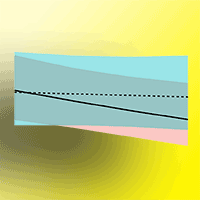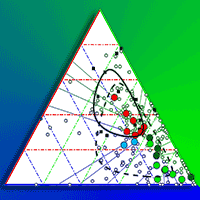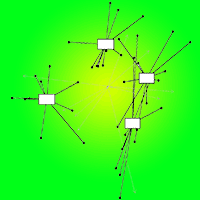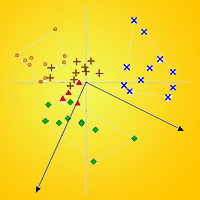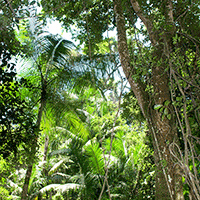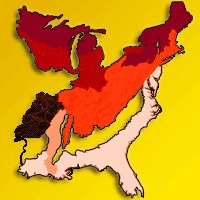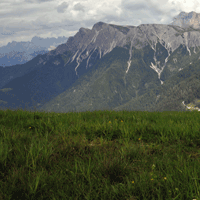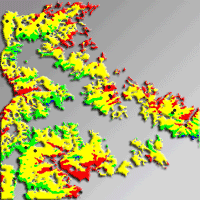Temperate forest ecosystems, including old-growth fragments, are subject to increasing pressures, both from biotic and abiotic factors. Frequent disturbance events, rising mean annual temperatures and longer-lasting droughts are causing changes in tree species composition, probably shifting the altitudinal distribution of herbaceous species as well. Our goal was to examine whether such shifts can be observed even in old-growth temperate forests, and if the changes in the species composition and spatial distribution of trees is reflected in the herbaceous layer. Our study was based on a survey of several old-growth forests from the 1970s that was repeated after 30 years. Using spatial point pattern methods and generalized linear mixed effect models, repeated measurements of mapped phytosociological relevés and detailed maps of tree positions from two survey periods allowed us to examine how the species composition of the herb layer and the spatial distribution of trees ≥ 10 cm DBH (diameter at breast height) changed over 30 years. On most of the studied sites, the total number of trees declined and the proportion of broadleaves increased between the two surveys. Analyses of tree spatial distribution showed a general shift from a regular spatial distribution in the 1970s to a clustered spatial distribution of trees in the 2000s. In the 2000s, herbaceous species showed an upwards shift in their distribution compared to the 1970s, even after accounting for the effect of changing tree spatial distributions in both survey periods. These effects could be an outcome of warmer and drier weather conditions during the past decades. Further investigation is needed to examine whether this trend is related to changes in climatic conditions.
Keywords
, , , ,
Citation
Unar P, Janík D, Adam D, Holík J (2022). Changes in tree layer and altitudinal distribution of herbaceous species in temperate old-growth forests over 30 years. iForest 15: 206-212. - doi: 10.3832/ifor3749-015
Academic Editor
Paola Mairota
Paper history
Received: Jan 11, 2021
Accepted: Apr 17, 2022
First online: Jun 11, 2022
Publication Date: Jun 30, 2022
Publication Time: 1.83 months
© SISEF - The Italian Society of Silviculture and Forest Ecology 2022
Open Access
This article is distributed under the terms of the Creative Commons Attribution-Non Commercial 4.0 International (https://creativecommons.org/licenses/by-nc/4.0/), which permits unrestricted use, distribution, and reproduction in any medium, provided you give appropriate credit to the original author(s) and the source, provide a link to the Creative Commons license, and indicate if changes were made.

Breakdown by View Type
(Waiting for server response...)
Article Usage
Total Article Views: 29321
(from publication date up to now)
Breakdown by View Type
HTML Page Views: 25118
Abstract Page Views: 2484
PDF Downloads: 1297
Citation/Reference Downloads: 0
XML Downloads: 422
Web Metrics
Days since publication: 1280
Overall contacts: 29321
Avg. contacts per week: 160.35
Article Citations
Article citations are based on data periodically collected from the Clarivate Web of Science web site
(last update: Mar 2025)
(No citations were found up to date. Please come back later)
Publication Metrics
by Dimensions ©
Articles citing this article
List of the papers citing this article based on CrossRef Cited-by.
(1)
Aldrich PR, Parker GR, Ward JS, Michler CH (2003)Spatial dispersion of trees in an old-growth temperate hardwood forest over 60 years of succession. Forest Ecology and Management 180: 475-491.
CrossRef |
Gscholar
(2)
Anderegg WR, Kane JM, Anderegg LD (2013)Consequences of widespread tree mortality triggered by drought and temperature stress. Nature Climate Change 3: 30-36.
CrossRef |
Gscholar
(3)
Baddeley A, Turner R (2005)Spatstat: an R package for analysing spatial point patterns. Journal of Statistical Software 12: 1-42.
CrossRef |
Gscholar
(4)
Baddeley A, Rubak E, Turner R (2015)Spatial point patterns: methodology and applications with R. Chapman and Hall/CRC, Boca Raton, FL, USA, pp. 828.
Online |
Gscholar
(5)
Bates D, Mächler M, Bolker B, Walker S (2015)fitting linear mixed-effects models using lme4. Journal of Statistical Software 67: 1-48.
CrossRef |
Gscholar
(6)
Baeten L, Bauwens B, De Schrijver A, De Keersmaeker L, Van Calster H, Vandekerkhove K, Roelandt B, Beeckman H, Verheyen K (2009)Herb layer changes (1954-2000) related to the conversion of coppice-with-standards forest and soil acidification. Applied Vegetation Science 12: 187-197.
CrossRef |
Gscholar
(7)
Bolker BM, Brooks ME, Clark CJ, Geange SW, Poulsen JR, Stevens MHH, White JSS (2009)Generalized linear mixed models: a practical guide for ecology and evolution. Trends in Ecology and Evolution 24: 127-135.
CrossRef |
Gscholar
(8)
Bréda N, Huc R, Granier A, Dreyer E (2006)Temperate forest trees and stands under severe drought: a review of ecophysiological responses, adaptation processes and long-term consequences. Annals of Forest Science 63: 625-644.
CrossRef |
Gscholar
(9)
Burnham K, Anderson D (2002)Model selection and multimodel inference: a practical information-theoretic approach (2nd edn). Springer, New York, USA, pp. 488.
Gscholar
(10)
Danek P, Vrška T (2019)Four decades of the coexistence of beech and spruce in a Central European old-growth forest. Which succeeds on what soils and why? Plant and Soil 437 (1): 257-272.
CrossRef |
Gscholar
(11)
De Frenne P, Rodríguez-Sánchez F, De Schrijver AN, Coomes DA, Hermy M, Vangansbeke P, Verheyen K (2015)Light accelerates plant responses to warming. Nature Plants 1: 1-3.
CrossRef |
Gscholar
(12)
Degen T, Devillez F, Jacquemart AL (2005)Gaps promote plant diversity in beech forests (
Luzulo-Fagetum), North Vosges, France. Annals of Forest Science 62: 429-440.
CrossRef |
Gscholar
(13)
Efron B, Tibshirani RJ (1993)An introduction to the bootstrap. Chapman and Hall, New York, USA, pp. 456.
Online |
Gscholar
(14)
Getzin S, Wiegand T, Wiegand K, He F (2008)Heterogeneity influences spatial patterns and demographics in forest stands. Journal of Ecology 96: 807-820.
CrossRef |
Gscholar
(15)
Graf W, Kleinn C, Schall P, Nauss T, Detsch F, Magdon P (2019)Analyzing the relationship between historic canopy dynamics and current plant species diversity in the herb layer of temperate forests using long-term Landsat time series. Remote Sensing of Environment 232: 111305.
CrossRef |
Gscholar
(16)
Hanson JJ, Lorimer CG (2007)Forest structure and light regimes following moderate wind storms: Implications for multi-cohort management. Ecological Applications 17: 1325-1340.
CrossRef |
Gscholar
(17)
Harrison S, Damschen EI, Grace JB (2010)Ecological contingency in the effects of climatic warming on forest herb communities. Proceedings of the National Academy of Sciences USA 107: 19362-19367.
CrossRef |
Gscholar
(18)
Helm N, Essl F, Mirtl M, Dirnböck T (2017)Multiple environmental changes drive forest floor vegetation in a temperate mountain forest. Ecology and Evolution 7: 2155-2168.
CrossRef |
Gscholar
(19)
Illian JB, Penttinen A, Stoyan H, Stoyan D (2008)Statistical analysis and modelling of spatial point patterns. John Wiley and Sons, Chichester, UK, pp. 560.
Online |
Gscholar
(20)
Jaloviar P, Saniga M, Kucbel S, Pittner J, Vencurik J, Dovciak M (2017)Seven decades of change in a European old-growth forest following a stand-replacing wind disturbance: a long-term case study. Forest Ecology and Management 399: 197-205.
CrossRef |
Gscholar
(21)
Janík D, Adam D, Hort L, Král K, Samonil P, Unar P, Vrska T (2016a)Breaking through beech: a three-decade rise of sycamore in old-growth European forest. Forest Ecology and Management 366: 106-117.
CrossRef |
Gscholar
(22)
Janík D, Král K, Adam D, Hort L, Samonil P, Unar P, Vrška T, McMahon S (2016b)Tree spatial patterns of
Fagus sylvatica expansion over 37 years. Forest Ecology and Management 375: 134-145.
CrossRef |
Gscholar
(23)
Kenderes K, Král K, Vrška T, Standovár T (2009)Natural gap dynamics in a Central European mixed beech-spruce-fir old-growth forest. Ecoscience 16: 39-47.
CrossRef |
Gscholar
(24)
Kowalski T (2006)Chalara fraxinea sp. nov. associated with dieback of ash (
Fraxinus excelsior) in Poland. Forest Pathology 36: 264-270.
CrossRef |
Gscholar
(25)
Král K, Vrška T, Hort L, Adam D, Samonil P (2010)Developmental phases in a temperate natural spruce-fir-beech forest: determination by a supervised classification method. European Journal of Forest Research 129: 339-351.
CrossRef |
Gscholar
(26)
Law R, Illian J, Burslem DFR, Gratzer G, Gunatilleke CVS, Gunatilleke IAUN (2009)Ecological information from spatial patterns of plants: insights from point process theory. Journal of Ecology 97: 616-628.
CrossRef |
Gscholar
(27)
Lebourgeois F, Rathgeber CB, Ulrich E (2010)Sensitivity of French temperate coniferous forests to climate variability and extreme events (
Abies alba, Picea abies and
Pinus sylvestris). Journal of Vegetation Science 21: 364-376.
CrossRef |
Gscholar
(28)
Lenoir J, Gégout JC, Marquet PA, De Ruffray P, Brisse H (2008)A significant upward shift in plant species optimum elevation during the 20th century. Science 320: 1768-1771.
CrossRef |
Gscholar
(29)
Lutz JA, Larson AJ, Furniss TJ, Donato DC, Freund JA, Swanson ME, Bible KJ, Chen J, Franklin JF (2014)Spatially nonrandom tree mortality and ingrowth maintain equilibrium pattern in an old-growth
Pseudotsuga-Tsuga forest. Ecology 95: 2047-2054.
CrossRef |
Gscholar
(30)
Müller J, Bußler H, Goßner M, Rettelbach T, Duelli P (2008)The European spruce bark beetle
Ips typographus in a national park: from pest to keystone species. Biodiversity and Conservation 17: 2979-3001.
CrossRef |
Gscholar
(31)
Muscolo A, Bagnato S, Sidari M, Mercurio R (2014)A review of the roles of forest canopy gaps. Journal of Forestry Research 25: 725-736.
CrossRef |
Gscholar
(32)
Naaf T, Wulf M (2010)Habitat specialists and generalists drive homogenization and differentiation of temperate forest plant communities at the regional scale. Biological Conservation 143: 848-855.
CrossRef |
Gscholar
(33)
Nagel TA, Iacopetti G, Javornik J, Rozman A, De Frenne P, Selvi F, Verheyen K (2019)Cascading effects of canopy mortality drive long-term changes in understorey diversity in temperate old-growth forests of Europe. Journal of Vegetation Science 30: 905-916.
CrossRef |
Gscholar
(34)
Pruša E (1985)Die böhmischen und mährischen Urwälder - ihre Structur und Ökologie [The Bohemian and Moravian primeval forests - their structure and ecology]. Academia, Praha, Czech Republic, pp. 577.
Gscholar
(35)
R Core Team (2020)R: a language and environment for statistical computing. R Foundation for Statistical Computing, Vienna, Austria.
Online |
Gscholar
(36)
Saniga M (1999)Struktúra, produkčné pomery a regeneračné procesy Badinského pralesa [Structure, production conditions and regeneration processes of the Badinský forest]. Journal of Forest Science 45: 121-130.
Gscholar
(37)
Seidl R, Thom D, Kautz M, Martin-Benito D, Peltoniemi M, Vacchiano G, Wild J, Ascoli D, Petr M, Honkaniemi J, Lexer MJ, Trotsiuk V, Mairota P, Svoboda M, Fabrika M, Nagel TA, Reyer CPO (2017)Forest disturbances under climate change. Nature Climate Change 7: 395-402.
CrossRef |
Gscholar
(38)
Stanisci A, Frate L, Morra Di Cella U, Pelino G, Petey M, Siniscalco C, Carranza ML (2016)Short-term signals of climate change in Italian summit vegetation: observations at two GLORIA sites. Plant Biosystems 150: 227-235.
CrossRef |
Gscholar
(39)
Stoyan D, Stoyan H (1994)Fractals, random shapes and point fields: methods of geometrical statistics. John Wiley and Sons, Chichester, UK, pp. 389.
Gscholar
(40)
Stoyan D, Penttinen A (2000)Recent applications of point process methods in forestry statistics. Statistical Science 15: 61-78.
Online |
Gscholar
(41)
Szwagrzyk J, Szewczyk J (2001)Tree mortality and effects of release from competition in an old-growth
Fagus-Abies-Picea stand. Journal of Vegetation Science 12: 621-626.
CrossRef |
Gscholar
(42)
Thom D, Rammer W, Seidl R (2017)Disturbances catalyze the adaptation of forest ecosystems to changing climate conditions. Global Change Biology 23: 269-282.
CrossRef |
Gscholar
(43)
Thom D, Sommerfeld A, Sebald J, Hagge J, Müller J, Seidl R (2020)Effects of disturbance patterns and deadwood on the microclimate in European beech forests. Agricultural and Forest Meteorology 291: 108066.
CrossRef |
Gscholar
(44)
Verheyen K, Baány M, Chećko E, Chudomelová M, Closset-Kopp D, Czortek P, Decocq G, De Frenne P, De Keersmaeker L, Enríquez García C, Fabšičová M, Grytnes JA, Hederová L, Hédl R, Heinken T, Schei FH, Horváth S, Jaroszewicz B, Jermakowicz E, Klinerová T, Kolk J, Kopecky M, Kuras I, Lenoir J, Macek M, Máliš F, Martinessen TC, Naaf T, Papp L, Papp-Szakály A, Pech P, Petrík P, Prach J, Reczynska A, Spicher F, Standovár T, Swierkosz K, Szczesniak E, Tóth Z, Ujházy K, Ujházyová M, Vangansbeke P, Vild O, Wulf M, Baeten L (2018)Observer and relocation errors matter in resurveys of historical vegetation plots. Journal of Vegetation Science 29: 812-823.
CrossRef |
Gscholar
(45)
Vrška T, Hort L, Adam D, Odehnalová P, Horal D (2002)Developmental dynamics of virgin forest reserves in the Czech Republic I. Ceskomoravská vrchovina Upland - Polom, Zákova hora Mt. Academia, Praha, Czech Republic, pp. 213.
Gscholar
(46)
Vrška T, Adam D, Hort L, Kolár T, Janik D (2009)European beech (
Fagus sylvatica L.) and silver fir (
Abies alba Mill.) rotation in the Carpathians: a developmental cycle or a linear trend induced by man? Forest Ecology and Management 258: 347-356.
CrossRef |
Gscholar
(47)
Vrška T, Unar P, Hort L, Adam D, Král K, Janík D (2012)Developmental dynamics of virgin forest reserves in the Czech Republic III. Šumava Mts. and Ceský les Mts. - Diana, Stožec, Boubín virgin forest, Milešice virgin forest. Academia, Praha, Czech Republic, pp. 238. [ISBN 80-200-0908-6]
Gscholar
(48)
Walther GR, Beißner S, Burga CA (2005)Trends in the upward shift of alpine plants. Journal of Vegetation Science 16: 541-548.
CrossRef |
Gscholar
(49)
Zellweger F, De Frenne P, Lenoir J, Vangansbeke P, Verheyen K, Bernhardt-Römermann M, Baeten L, Hédl R, Berki I, Brunet J, Van Calster H, Chudomelová M, Decocq G, Dirnböck T, Durak T, Heinken T, Jaroszewicz B, Kopecky M, Máliš F, Macek M, Marek M, Naaf T, Nagel TA, Ortmann-Ajkai A, Petrik A, Pielech R, Reczynska A, Schmidt W, Standovár T, Swierkosz K, Teleki B, Vild O, Wulf M, Coomes D (2020)Forest microclimate dynamics drive plant responses to warming. Science 368: 772-775.
CrossRef |
Gscholar
